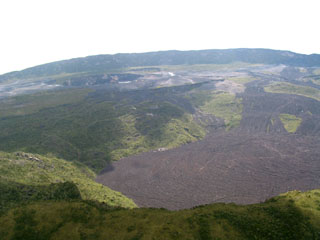Report on Nyamulagira (DR Congo) — 1 May-7 May 2019
Smithsonian Institution / US Geological Survey
Weekly Volcanic Activity Report, 1 May-7 May 2019
Managing Editor: Sally Sennert.
Please cite this report as:
Global Volcanism Program, 2019. Report on Nyamulagira (DR Congo) (Sennert, S, ed.). Weekly Volcanic Activity Report, 1 May-7 May 2019. Smithsonian Institution and US Geological Survey.
Nyamulagira
DR Congo
1.408°S, 29.2°E; summit elev. 3058 m
All times are local (unless otherwise noted)
The Observatoire Volcanologique de Goma (OVG) reported that during early April Nyamuragira’s lava lake, which had returned in April 2018 after almost a year of quiet, continued to be active. Beginning on 12 April seismic and lava-lake activity both declined. MIROVA data showed that the thermal radiative power was at moderate levels the first half of the month then declined to low levels during the second half.
Geological Summary. Africa's most active volcano, Nyamulagira (also known as Nyamuragira), is a massive high-potassium basaltic shield about 25 km N of Lake Kivu and 13 km NNW of the steep-sided Nyiragongo volcano. The summit is truncated by a small 2 x 2.3 km caldera that has walls up to about 100 m high. Documented eruptions have occurred within the summit caldera, as well as from the numerous flank fissures and cinder cones. A lava lake in the summit crater, active since at least 1921, drained in 1938, at the time of a major flank eruption. Recent lava flows extend down the flanks more than 30 km from the summit as far as Lake Kivu; extensive lava flows from this volcano have covered 1,500 km2 of the western branch of the East African Rift.

